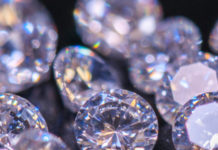[miningmx.com] — THE surprise decision earlier this month to pull the
$1bn Hong Kong listing of UK jeweller, Graff Diamonds, provides some market
intelligence regarding business confidence in Asia currently, if not globally.
Graff Diamonds sells jewellery to the ultra-rich; in fact, 20 customers have
comprised two-fifths of the company’s revenue for each of the last three years.
That investors should doubt the revenue model of a company that sells to the most
resilient segment of the market – those who can afford not to care much about the
market – says something of the depth of uncertainty among investors.
The diamond market, however, is just taking a breather, according to Des Kilalea, an
analyst for RBC Capital Markets. Prices for so-called “rough diamonds’ are merely
“marking time’ after an upward movement in price dating from the fourth quarter.
“Our view is that, provided the leading producers are restrained in what they offer
for sale and in the level of their prices, the second half of the year should see
further improvement,’ Kilalea said in a note.
The optimism, at least from a medium-term perspective, is supported by limited
supply growth, especially as both BHP Billiton and Rio Tinto look to exit the diamond
production market. Both companies have said they intend to sell their producing
mines – although, interestingly, a buyer is yet to be found for either.
The departure of both BHP Billiton and Rio Tinto also sees the end of their capital
expenditure in the diamond sector. This could mean even slower supply growth in
the future.
Secondly, says Kilalea, China and India remain strong demand nodes for diamonds,
notwithstanding the wobble with the Graff Diamonds listing. Kilalea believes that
these two countries will account for a third of the market by 2020.
Thirdly, the US remains an important market. A surge in demand is expected as
consumer confidence recovers.
Philippe Mellier, the newly appointed CEO of De Beers, told Bloomberg News
last week following a presentation at GIBS in Johannesburg that the company’s
second-half diamond sales would also be boosted by two political events: the
handover of power in China and the election in the US. Both events, once
completed, will settle nerves and instil the kind of optimism where people feel love,
expressed materially, is back on the agenda.
“It’s statistical, it’s not me,’ Mellier told the newswire service.
From an Anglo American perspective, the dominant shareholder in De Beers, first-
half rough diamond sales are expected to be about $3bn, a 15% decline year-on-
year. Kilalea believes this shouldn’t be a surprise to anyone in the market.
Rough diamond prices for the Diamond Trading Company, the vehicle through which
De Beers sells its rough diamonds, in the first quarter of last year were 35% higher,
and 42% higher at the year-end point, which is end-June.
For the 2011 calendar year, however, prices were 29% stronger, which already
suggests the second half of the calendar year saw weaker prices. “So a small
recovery in prices in Q1 2012 is all that could have been expected,’ says Kilalea.
– Finweek










